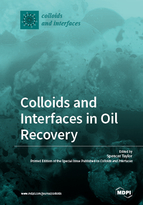Colloids and Interfaces in Oil Recovery
A special issue of Colloids and Interfaces (ISSN 2504-5377).
Deadline for manuscript submissions: closed (31 May 2018) | Viewed by 67718
Special Issue Editor
Interests: asphaltenes; coalescence and demulsification; crude oils and bitumens—composition and surface properties; emulsions and microemulsions; enhanced oil recovery; industrial colloidal and interfacial systems; surface and interfacial chemistry of petroleum fuels; surfactants; wettability
Special Issues, Collections and Topics in MDPI journals
Special Issue Information
Dear Colleagues,
The advent of alternative energy technologies continues to reduce the world’s requirement for fossil fuels, especially crude oil, which furnishes most liquid hydrocarbon fuels. Realistically, however, it is likely to be many decades before the last drop of crude oil is produced.
In the meantime, the oil industry continues to work towards improved efficiency, in terms of recovery and refining, which will reduce the impact of this energy source on the global environment.
It has long been recognized that the joint roles of colloidal and interfacial science are significant in oil recovery. For example, ever since the design of surfactants for tertiary (enhanced) oil recovery (EOR) in the 1960 and 1970s, the inter-relationship between ultralow interfacial tension and microemulsion formation have been intimately linked.
However, it has always been the case that economic factors have dictated the direction taken by the oil industry, and a relatively low oil price restricted the use of surfactant-based EOR processes in the 1980s. Subsequently, decreasing recoverable conventional oil resources, combined with an increasing oil price, led to the exploitation of heavy oil and bitumen using mining or energy-intensive steam-based technologies assuming more importance.
In parallel with the increase in heavy oil production, efforts continued to improve the efficiency of conventional oil production. In particular, the past two decades have seen interesting approaches being developed which are directed at improving the incremental recovery of conventional oil, utilizing colloid and interface science principles. For example, reservoir wettability can be altered during waterflooding through the application of nanoparticles or by changing the ionic composition of the water.
These and other topics will be covered in this Special Issue.
- Interfacial processes in oil recovery
- Nanotechnology in oil recovery
- Surfactant-based oil recovery
- Enhanced oil recovery (EOR)
- Waterflooding and salinity effects
- Application of colloids and interfaces in conventional and heavy oil recovery
- Emulsions in oil recovery
- Separation methods during oil recovery
- Crude oil/brine/rock systems
Prof. Dr. Spencer Taylor
Guest Editor
Manuscript Submission Information
Manuscripts should be submitted online at www.mdpi.com by registering and logging in to this website. Once you are registered, click here to go to the submission form. Manuscripts can be submitted until the deadline. All submissions that pass pre-check are peer-reviewed. Accepted papers will be published continuously in the journal (as soon as accepted) and will be listed together on the special issue website. Research articles, review articles as well as short communications are invited. For planned papers, a title and short abstract (about 100 words) can be sent to the Editorial Office for announcement on this website.
Submitted manuscripts should not have been published previously, nor be under consideration for publication elsewhere (except conference proceedings papers). All manuscripts are thoroughly refereed through a single-blind peer-review process. A guide for authors and other relevant information for submission of manuscripts is available on the Instructions for Authors page. Colloids and Interfaces is an international peer-reviewed open access semimonthly journal published by MDPI.
Please visit the Instructions for Authors page before submitting a manuscript. The Article Processing Charge (APC) for publication in this open access journal is 1600 CHF (Swiss Francs). Submitted papers should be well formatted and use good English. Authors may use MDPI's English editing service prior to publication or during author revisions.






